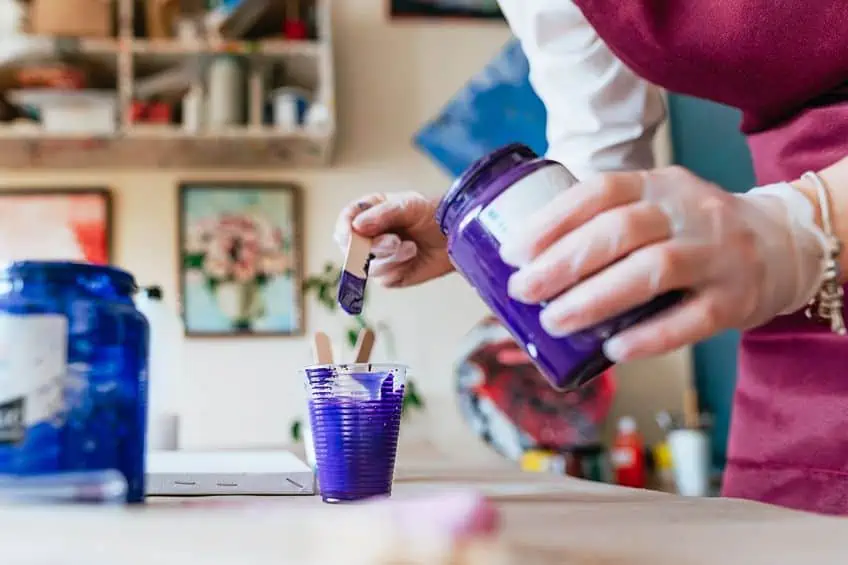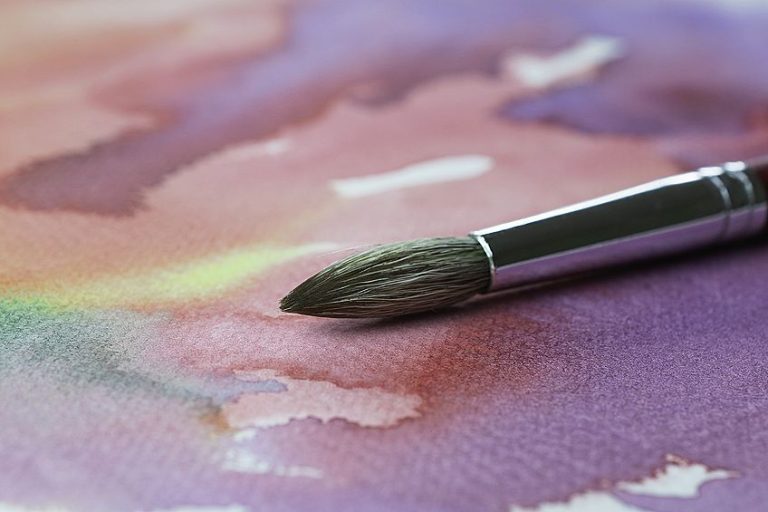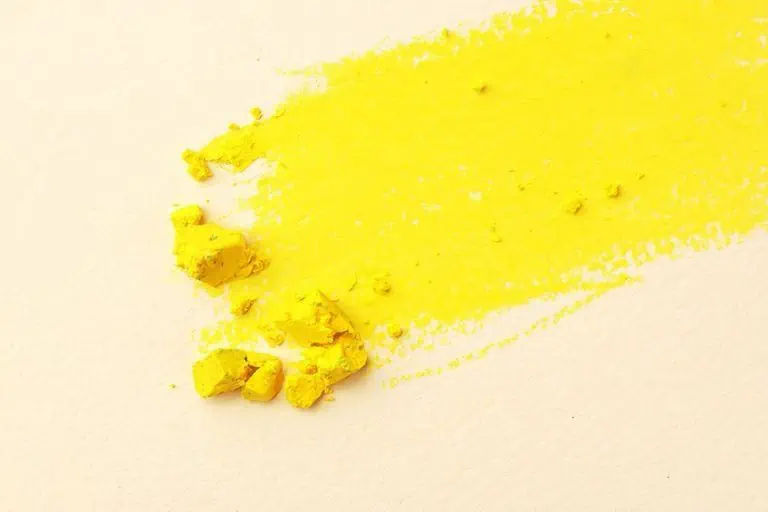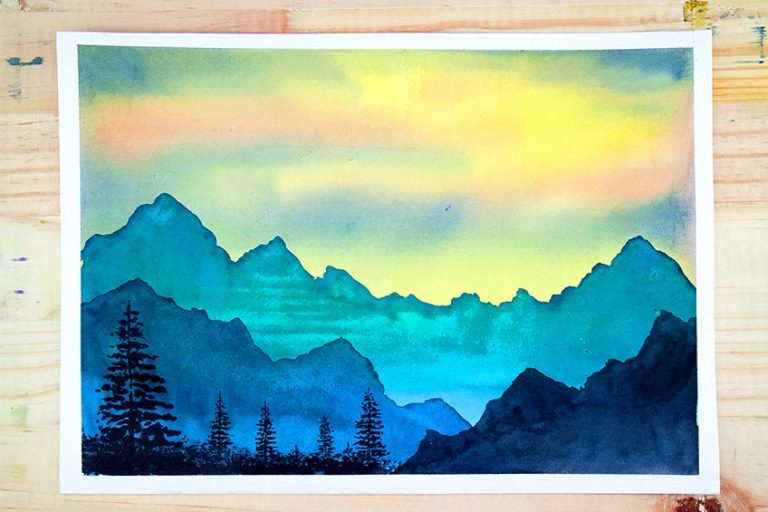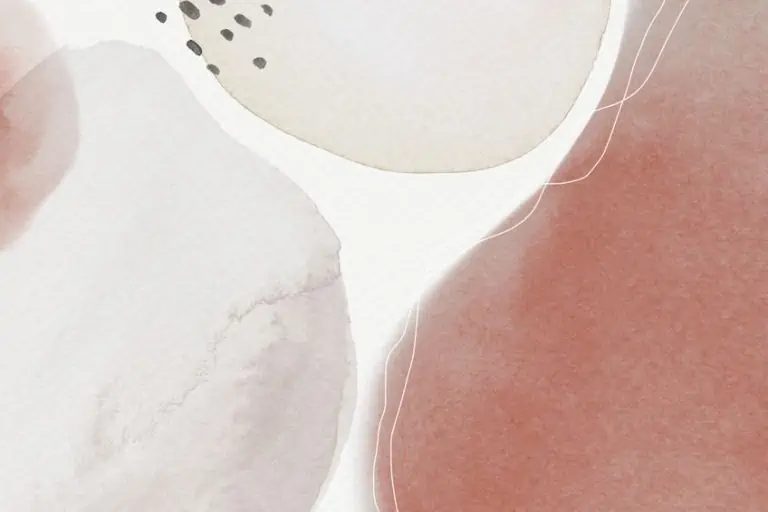How to Make Acrylic Paint – The Benefits of Making Your Own Paint
This post may contain affiliate links. We may earn a small commission from purchases made through them, at no additional cost to you.
Thanks to its amazing versatility, acrylic paint has grown into one of the most popular and widespread painting mediums today. Creating your own DIY acrylic paint can be a fun and cost-effective alternative to buying it and gives you more flexibility with this amazing medium. Below, we have created a step-by-step guide on how to make acrylic paint at home for you to follow!
Table of Contents
What Is Acrylic Paint?
Acrylic paint is a popular water-based paint made from pigment and an acrylic polymer. Alongside oil paint, acrylic paint is one of the most popular painting mediums used today, which is largely due to its versatility. You can use acrylic paints on many different surfaces and easily change its viscosity. This allows it to be used for a variety of painting projects and techniques.
Unlike oil paints, acrylic paints are also non-toxic, dry quicker, and do not make use of harsh solvents.
Why Make Homemade Acrylic Paint?
From saving money, giving you more flexibility in your painting, and controlling the ingredients, there are many benefits to making your own paints. What’s more, knowing how to make acrylic paints will make you more knowledgeable about the materials used in your paint, as well as improve your skills when using the paint itself.
Saves You Money
The cost of buying separate pigment and medium is generally less expensive than buying ready-made, particularly regarding artist-grade acrylic paints. This is because you need very little pigment to make enough paint to complete entire paintings. If you need large quantities of paint to cover a large canvas, making your own paints is a great option to save you money.

Increased Control and Flexibility
With homemade acrylic paint, you have much more control and flexibility over the color and consistency of your paints, because you have full control of the ratio of pigment to medium when you make your own paint as well as the type of medium and pigment you use. This allows you to get the exact color, opacity, and viscosity of paint needed for your piece. You can also mix the right amount of paint, meaning there is less wastage and you will never run out in the middle of a painting session as long as you have the materials.
Choose Your Own Ingredients
While acrylic paints are generally considered non-toxic, this just means that the ingredients of acrylic paint lie within safety limits, not that they are free of toxins altogether. Even some of the pigments in store-bought paints, such as manganese, cobalt, and cadmium can be toxic, so making your own paints gives you greater control over what is in them. Aside from the pigments and medium, acrylic paints can also have other additives and preservatives such as plasticizers, ammonia, formaldehyde, and benzene, which are known to have adverse effects.
Mixing your own DIY acrylic paint can also produce a paint that is more vibrant and with increased longevity, compared to store-bought paints with the same cost.
Tools and Materials Needed for Making Your Own Paints
Now that you know about the benefits of making paints, you might be wondering how to make acrylic paint. There are a few main ingredients of acrylic paint that you will need to make your own homemade acrylic paint. These include:
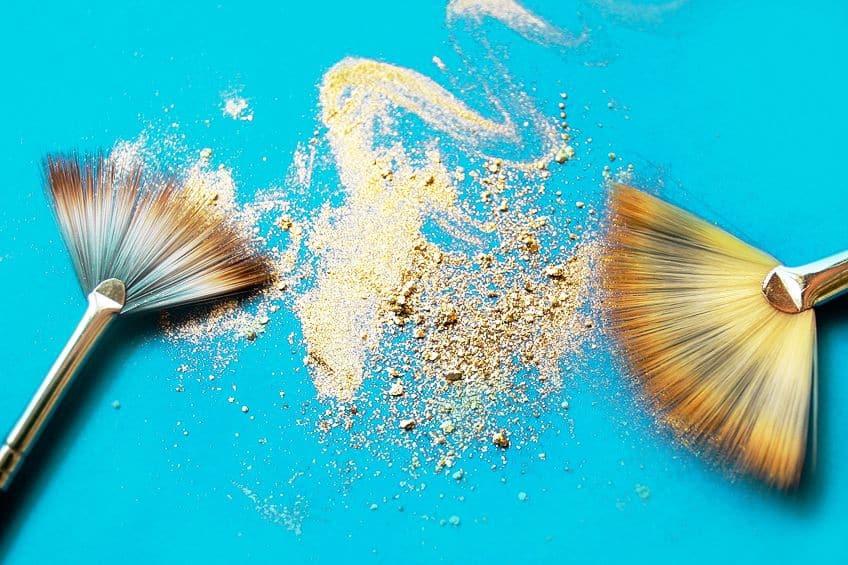
- Pigment
- Clear alcohol or water
- Glass muller or steel spatula
- An acrylic binder or base
- Glass surface to mix on
- Dust mask
- Pipette
Pigments
Your paint pigments are the most important aspect of making your own paints. Today, there are three main varieties of pigments, namely organic, inorganic, and lake pigments. Each of these pigments are widely available online and at art and hardware stores, and have their own advantages and disadvantages, so be sure to choose one that is right for you.
Organic and Inorganic Pigments
Contrary to what the name might make you think, organic pigments are not always naturally found in nature, but are rather made from carbon compounds. These pigments are often chemically synthesized, are generally considered less toxic than other pigments, and produce a more translucent paint. While they are more expensive and more difficult to work with compared to inorganic pigments, organic pigments produce more vibrant, rich, and glossy paints, which tend to be more stable when exposed to weather and solvents thanks to their strong carbon bonds. Organic pigments include Azo pigments, which produce warm hues such as red, yellow, and orange, Phthalocyanine pigments, which produce warm and cool blues and greens, and Quinacridones, which produces violet, orange, and red paints.
Inorganic pigments have a more natural origin than organic pigments and typically come from various salts and minerals.
Inorganic pigments are less complicated to work with than organic pigments but also tend to be more toxic. These pigments are based on compounds such as sulfate, oxide, carbonate, and sulfide. Inorganic pigments tend to be cheaper than organic pigments, are more opaque, and have more lightfastness, meaning that they are more resistant to fading when exposed to light. This is due to their lack of carbon bonds, which gradually break down when exposed to sunlight. Inorganic pigments, however, are often dull compared to organic pigments and need other additives to achieve the same tone and brightness of these paints. Inorganic pigments include Titanium Oxide, which creates an opaque white, Cadmium pigments, which produce warm hues like reds, oranges, and yellows, Metallic pigments, which are used to produce metallic paints, and Chromium Oxide, which can create a variety of blues and greens.
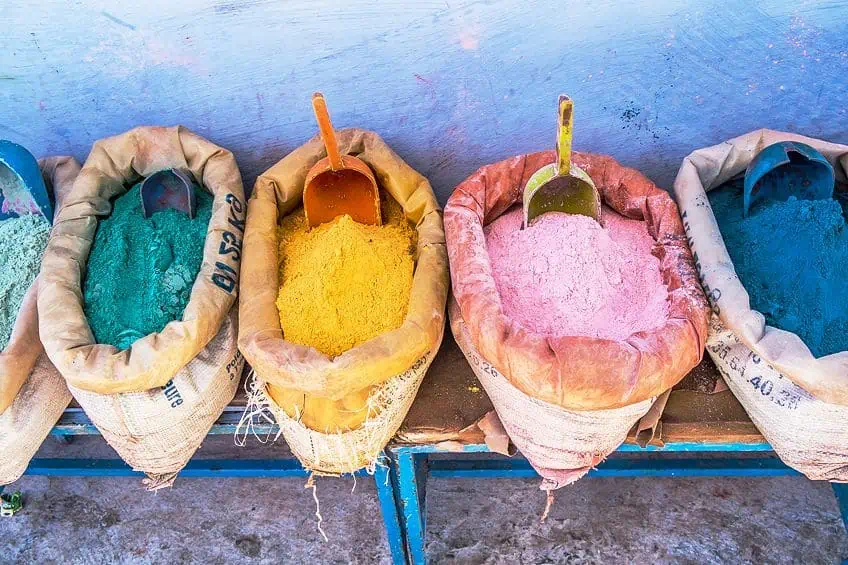
| Pigment Type | Organic | Inorganic |
| Color Availability | Less colors available | Comprehensive range of colors available |
| Color Brightness | Bright | Dull |
| Opacity | Translucent | Opaque |
| Cost | Expensive | Inexpensive |
| Light Fastness | Vary, but generally poor | Good |
| Safety | Usually safe | Can be toxic |
| Solubility | Have some solubility | Insoluble in solvents |
Lake Pigments
A third type of pigment are lake pigments, which are created by combining an organic dye, usually made from plant matter, with a metallic salt or another inert binder. Lake pigments are not widely used as they can be expensive to produce and vary greatly in their colorfastness, light fastness, and stability. These can be a bit complicated to work with as they cannot be used with certain thinners or binders and therefore act more as dyes.
The toxicity of these pigments is also largely dependent on the material used to create the dye. The color that these pigments produce is largely dependent on the metallic salt that was used.
Acrylic Paint Bases
Acrylic bases, also known as acrylic binders or emulsions, are what ensure that your pigment adheres to your painting surface. The acrylic base you use is very important to the final look and longevity of your DIY acrylic paint. The base forms the foundation of your paint and determines its opacity, consistency, and flexibility. Acrylic paint bases come in two main varieties namely, acrylic polymer bases and vinyl acrylic bases. Irrespective of which one you use, ensure that it is made for acrylic paints as oil paint varieties will not work.
Acrylic binders come in three main categories: mediums, gels, and pastes. Each of these categories has its own pros and cons and can have different effects on the look and feel of your final acrylic paint.
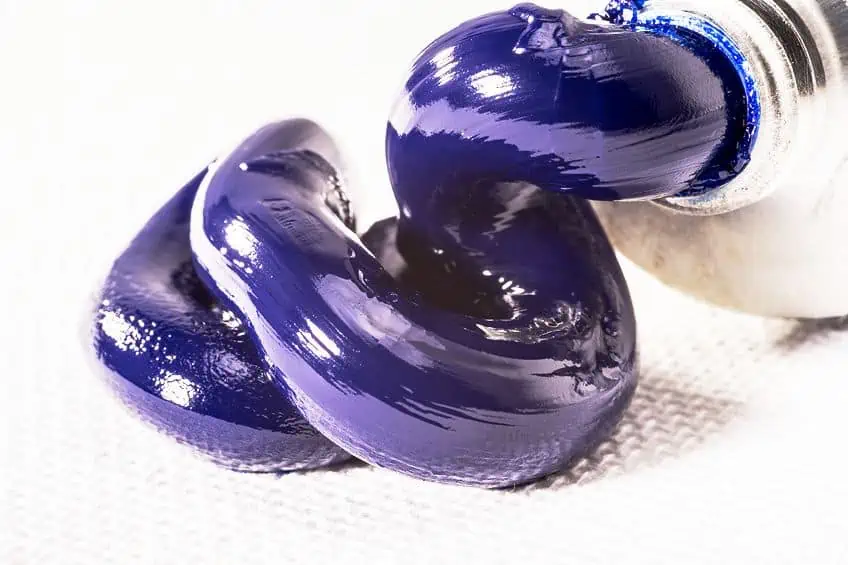
| Base Type | Finish | Viscosity | Drying Time |
| Gel | Gloss, semi-gloss, matte | Thick | Long |
| Medium | Gloss, semi-gloss, matte | Smooth | Long |
| Paste | Opaque | Thick | Short |
Acrylic Polymer Bases
This acrylic paint base is the most commonly used and is made using an acrylic resin, which has been dissolved in a solvent, usually water. Today, these bases typically contain polymethyl methacrylate (PMMA) or polyvinylidene chloride (PVDC). You can find acrylic polymer base at most hardware stores, and they are also largely available online.
Vinyl Acrylic Bases
This acrylic paint base is less popular than acrylic polymer base and uses a combination of PMMA mixed with other monomers such as vinyl acetate, styrene, and butadiene. These bases tend to have increased viscosity compared to acrylic polymer bases, and also tend to be more expensive. Vinyl acrylic bases are less widely available, although you can still find it in large hardware stores and some online retailers.
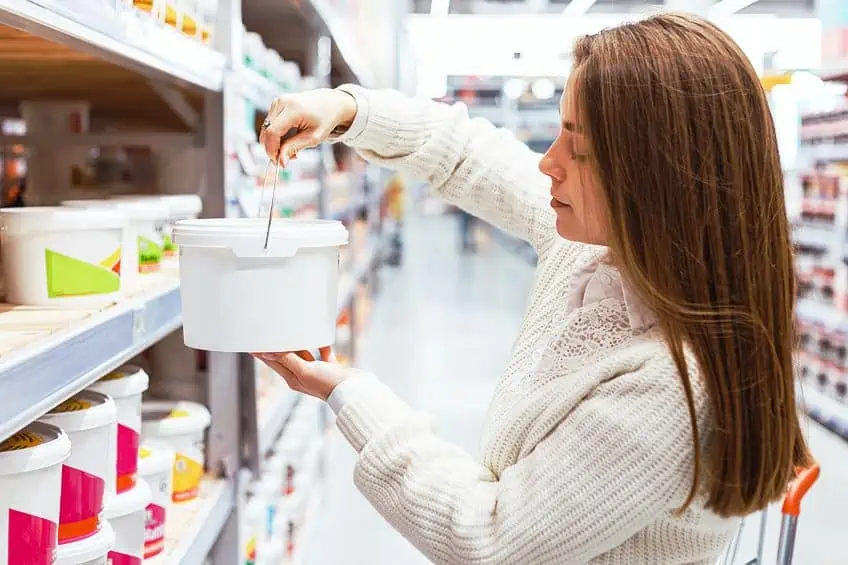
How to Make Acrylic Paint
Using a few simple tools and ingredients, you can easily make your own homemade acrylic paint. Below, we have created an easy step-by-step guide to walk you through this process, as well as some extra hints to help you along the way.
Step One: Prepare Your Pigment
The first step in making acrylic paints is mixing your paint pigment. When you are just starting, it is helpful to only mix one pigment or premixed pigment at a time until you have a better understanding of the paint-making process. This will ensure that you know how to achieve the right balance between pigment and base in your paint before complicating the process with color theory. Before you begin working with the pigments, be sure to put on a dust mask that covers both your mouth and nose. Start by measuring out the amount of pigment you wish to mix onto the glass surface. A half a tablespoon of pigment is a good starting point, which you can adjust in later batches to produce more or less paint.
If you are having trouble seeing your pigments, lay a blank sheet of paper under your glass surface to make it easier to see them.
Slowly add your water or alcohol to your pigments and disperse the pigment. Do not add any oils to disperse your pigments as they will not mix properly with your acrylic base. Pigments are generally easier to disperse in alcohol, particularly if you are using organic pigments as they tend to float in water. The alcohol, however, will make your paints dry slightly faster. If they dry too fast, you can add a small amount of water to the pigment after dispersing it in the alcohol.

Only add enough liquid to evenly disperse the pigment and achieve a sauce-like consistency, usually no more than a 50:50 ratio. Work in small amounts as too much alcohol or water will dilute your acrylic paint base later on. Some pigments can clump together when adding your liquid, particularly powdered earth pigments. Sifting the pigments before mixing them will remove large pieces and prevent them from clumping, allowing them to be more evenly dispersed.
Step Two: Grind Your Pigment
Once you have saturated your pigments, you can begin grinding them with even pressure using a muller or spatula. This process breaks up any lumps or clumps of pigment and ensures that your final paint will have a uniform color. Continue to grind your pigment until it has an even and smooth texture without any hard areas or lumps. Be sure to grind out as much of the grittiness as you can as any remaining granules will be visible in your paintings and might even result in accidental streaks of color in your work. If your pigment begins to dry out and become pasty during this stage, you can use the pipette to add more of the liquid in small amounts until you get the desired consistency.
You can also add more pigment if you find the mixture too thin.
Step Three: Add Your Acrylic Paint Base
Once your pigment has been evenly dispersed you can now add your chosen acrylic base. The exact ratio of base to pigment will vary across the different types and brands so be sure to follow the manufacturer’s instructions for your particular base. Simply add the required amount of base to the pigment mixture and mix until it is fully incorporated. Work slowly as it is easier to add more base than to add more pigment to your paints, and adding more pigment might change the final look of your paint color. It is very important to make sure that all remaining pigment grains have been worked out during this step.
Once your paint has been mixed it is now ready to use.
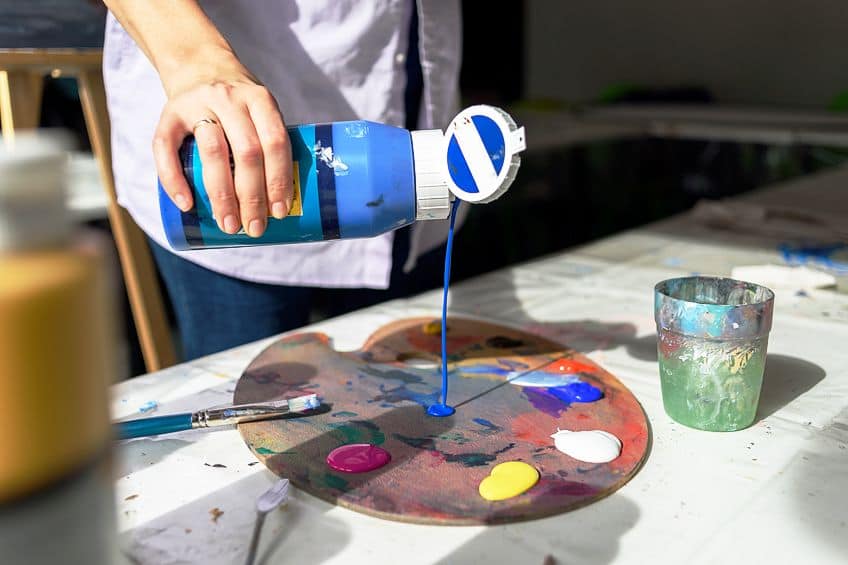
Safety Considerations When Making Acrylic Paint
Wearing latex or rubber gloves as well as a dust mask that covers your nose and mouth is an important safety precaution when mixing your own acrylic paints. This is especially important if you are unsure of the ingredients in your pigments or base. The mask will protect you from breathing in the fine pigment dust and the gloves will protect your skin from any harsh chemicals or staining. You can also wear protective eyewear as an extra precaution to ensure the dust does not get in your eyes.
Be sure to mix your paints in a well-ventilated area and keep any unused pigments or bases in sealed containers out of reach of children and animals.

Tips for Using Your DIY Acrylic Paint
Now that you know how acrylic paint is made, you might be wondering how you can use them in your art. Mixing your own paints allows you to experiment with different colors and textures in your paintings, making them truly unique.
Mixing Your Own Colors
Arguably the best part of making acrylic paint is the freedom that it gives you to create your own original colors by combining different pigments. While this can be a very rewarding experience, you will need to take note of the ratios of each paint recipe for each color if you wish to recreate them. A tip is to keep a notebook with the ratios of pigment to medium and a swatch of each color that you create for easy reference.
It is important to note when working with pigments, that each pigment will mix differently.
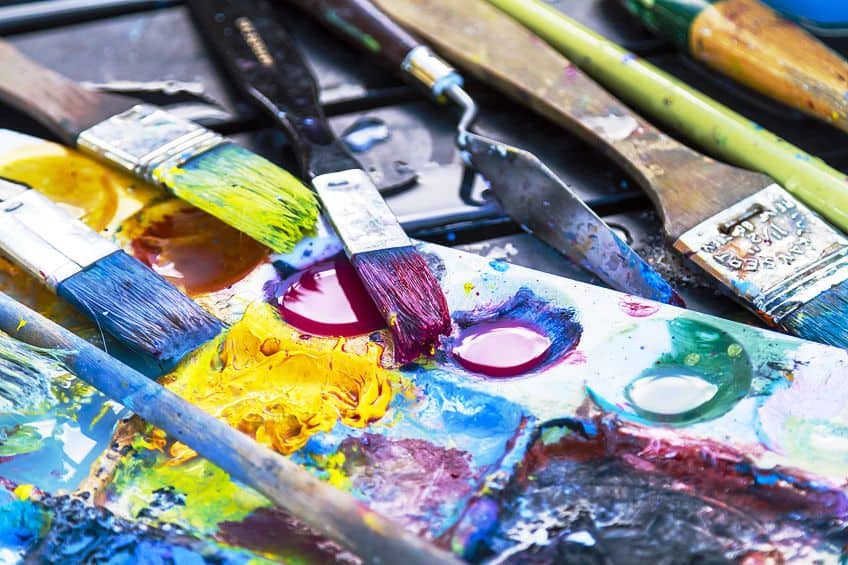
Therefore, some combinations of pigment can be dispersed easier than others and some pigments will not mix well together at all. You are also limited to the pigments that you have available, so if you need a specific color that you cannot make you may still need to buy it.
Adding Acrylic Painting Mediums
If you are looking to try something new, you can also add a painting medium to your homemade acrylic paint. Painting mediums are additives that you mix into your paints to change their properties. You can change the finish of your paint by adding a matte or gloss medium, you can speed up or slow down the drying time of your paints using a quick-drying medium or retarder respectively, and you can even thicken your paints for impasto painting or add a pouring medium to thin them.
Adding a textured medium is another great way to add a unique look and dimension to your paintings.
Storing Your Paint
Storing your homemade paint is very similar to storing store bought paints. For large quantities of paint, simply store it in an air-tight tube or glass container. For small quantities of paint, scoop them onto tin foil sheets and fold the sheets a few times tightly around your paints, being sure to push out as much air as you can. Be sure to add a date on the container for when the paint was made and store them in a warm, dry place.
Paints can be stored for up to six months and can be reactivated with a little water if they dry out.

There are many benefits to making your own paints that range from saving you money to giving you more control over your paints and its ingredients. Learning how acrylic paint is made is a great skill that gives you a better understanding of your paints and how to use them, while giving you the confidence and flexibility to bring your own unique colors into your art!
Frequently Asked Questions
How to Make Acrylic Paint at Home?
Making acrylic paint yourself requires three main ingredients. These are water or clear alcohol, pigment, and an acrylic base. Start by adding water or alcohol to your pigment in small amounts until the pigment is evenly distributed. Next, grind the pigment mixture with a metal spatula or glass muller until no clumps or large grains remain. Finally, add your acrylic base in small amounts and mix until you achieve your desired paint consistency.
What Are the Main Ingredients of Acrylic Paint?
Acrylic paints are made mainly using pigment that has been suspended within an acrylic polymer emulsion. Acrylic paints can also contain a variety of plasticizers, stabilizers, defoamers, and silicone oils, which are used to improve the longevity or performance of the paint.
Is Acrylic Paint Water or Oil Based?
Acrylic paint is a painting medium that is water-based. Acrylic paints consist of pigments and acrylic polymer binders, which are water-based polymers, whereas oil paints contain pigments and slow-drying oils.
Megan is a writer and researcher who graduated from the University of Cape Town with a degree in Social Sciences, specializing in Psychology and Environmental Science. Her passion for knowledge and leaving a positive impact has fueled her current work in conscious and sustainable growth in Southern Africa. Megan’s love of nature has also led her to train as an animal behaviorist. She works part-time training and rehabilitating dogs. Megan is interested in the physical and psychological effects of colors in our environment on our mood and well-being. In addition, she is concerned with how art and creativity have been an integral part of human society. Megan van Schoor has been writing blog posts on the topics of painting, drawing, and color theory for acrylgiessen since 2021.
Learn more about Megan van Schoor and about us.
